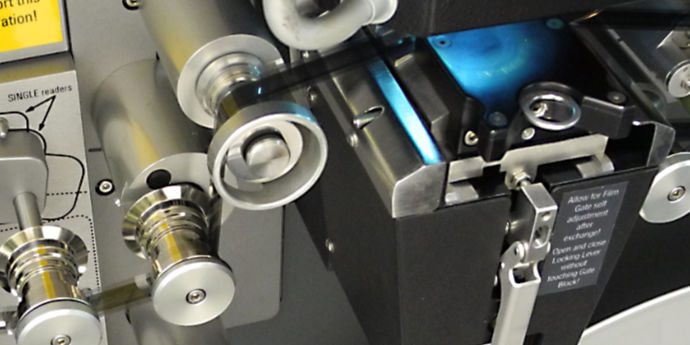The discovery of a Spirit Datacine at Cutting Edge in Brisbane, only two hours away, was a relief after the at-a-distance negative experience with the Sydney company. This time I could see the equipment for myself, and discuss in person what was needed.
So in March 2013 I arranged to visit Justin at Cutting Edge, to see the Spirit machine up close, and to discuss the process for having films scanned.

Various creative types came and went from the foyer while I was waiting for Justin. I was told that Cutting Edge is the largest film and video post-production operation in Brisbane, with about 60 employees at the time of my visit. Most of these were involved in visual effects — I saw a large room full of people working at screens — presumably animators and the like.
Justin explained that Cutting Edge had moved into their present premises within the past few years from a larger multi-storey facility which had included a full commercial kitchen and chef on the top floor! Apparently the GFC in 2008 caused a recession in the industry and the company had to downsize. In the previous building they had a large film library of old projects. Most of this was thrown out in the move to the new premises. They are all-digital nowadays.
The Spirit Datacine
Justin took me upstairs to the server room where the Spirit Datacine is housed. It had been relegated to this “back room” because it is seldom used nowadays — after being bought new for something like $1.6 million some years earlier! Another sobering sign of the rapid changes happening as the film industry transitions to fully digital workflows.





The Spirit is a “line scanner”, meaning that it scans just a single line of pixels at a time. A full-frame image is constructed from a series of these scan lines.
The “line scanner” design of the Spirit was “high tech” in the late 1990s when the Spirit was originally designed. (The latest scanners typically use full-frame CCDs, which can result in more stable images — a fact I didn’t discover until some time later.)
Running Some Tests
I had taken with me a couple of reels of the Tarax Show Pantomimes to test. We mounted both reels on the Spirit and Justin set the various controls to get an optimum scanning result. The scan could be previewed on the Spirit control console. Image quality was excellent. We were able to zoom in and see the original video raster lines on the film. Tonality and sharpness were also excellent considering the source of the material.

Resolution, Bit Depth and Compression Codecs
Regarding scanning resolution, the Spirit at Cutting Edge is a “2K” machine. It can scan up to 2048 x 1556 pixels resolution. The bit depth is 14 bits per pixel.
Justin recommended scanning at full resolution and bit depth, then doing a “grade” afterwards to crop to the frame boundaries and to adjust levels.
The eventual conversion of these scans to PAL SD, which has non-square pixels, will require keeping as much resolution as possible so there are plenty of pixels to sample down.
Uncompressed video at 2K resolution would be too large to store and transfer. A good compromise is to use a low-loss codec such as Apple ProRes. As a bonus the absence of colour information should result in efficient compression.
The focus now was on getting good quality scans from the Spirit machine and moving the project forward from there. It was time to go back home and prepare the films for scanning.
